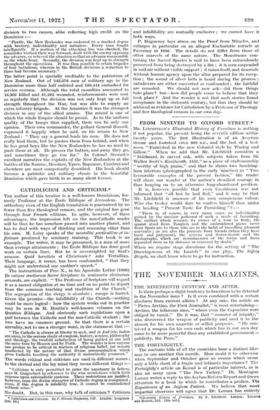FROM NINEVEH TO OXFORD STREET.* MR. LITCHFIELD'S Illustrated history of
Furniture is nothing
if not popular, the present being the seventh edition within twenty years. The first illustration is of an Assyrian throne and footstool circa 888 B.C., and the last of a bed- room " Furnished in the new Colonial style by Waring and
Gillow." When we add that Mr. Litchfield considers a " Sideboard, in carved oak, with subjects taken from Sir Walter Scott's Kenilworth, 1851," as a piece of craftsmanship " worthy of high praise," and that he shows two Sandring- ham interiors (photographed in the early 'nineties) as " Two favourable examples of the present fashion," the reader will share our wonder at the author's steadfast courage in thus hanging on to an otherwise long-abandoned position. It is, however, possible that even Casablanca was not informed that "all but he had fled," and it may be that Mr. Litchfield is unaware of his own conspicuous valour.
Who else to-day would dare to confess himself thus under the heading " Present Taste for Furnishing " ? :— " There is, of course, in very many cases, an individuality gained by the minium gatherwn of such a mode of furnishing. The cabinet which reminds its owner of a tour in Italy, the quaint stool from Tangiers and the embroidered piano cover from Spain are to those who are in the habit of travelling pleasant souvenirs ; as are also the presents from friends (when they have taste and judgment), the screens and flower-stands and the photographs, which are reminiscences of the forms and faces separated from us by distance or removed by death."
When we require stage directions for the setting of " The Drawing-room at the Laurels" in our play, The Safety Bicycle, we shall know where to go for instruction.


























































 Previous page
Previous page